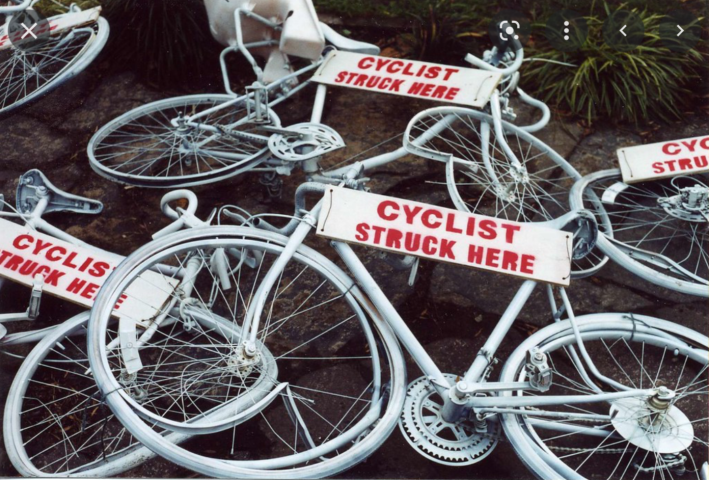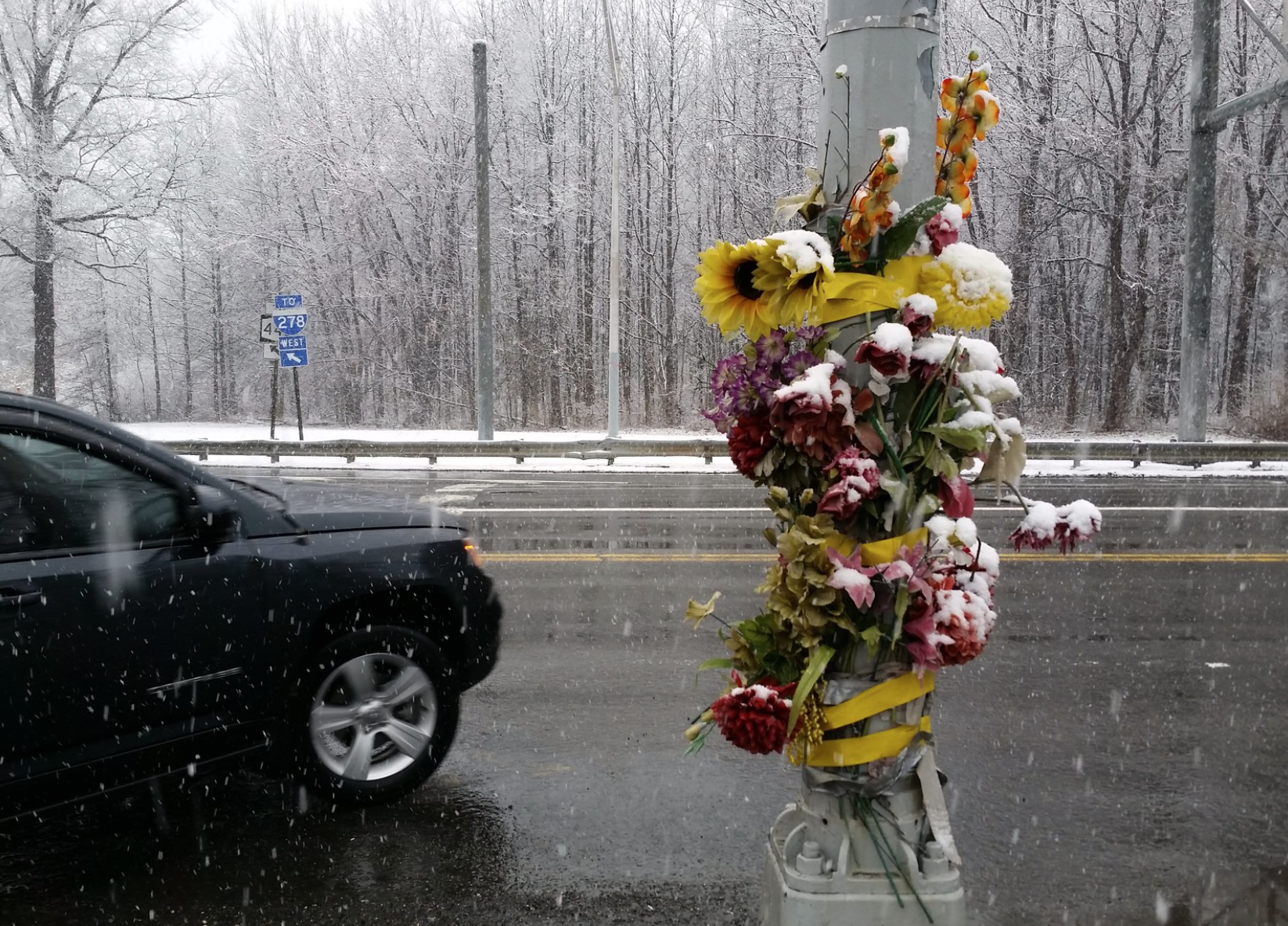Editor's note: World Day of Remembrance for Road Traffic Victims 2022 is Sunday, Nov. 20. More than 50 communities in 30 states are hosting events to commemorate the dead; Click here to find one near you.
Legend has it that sometime in the late 1920s, an Ohio governor issued an unusual (and possibly visionary) order: that after every fatal car crash, a marker would be placed on the site of tragedy to remind the public about the dangers of driving.
"But his successor said, 'You know, you're going to cover Ohio with crosses if you do this,'" adds historian Peter Norton. "So he reversed the practice."
Some of the details of the story may be apocryphal, but Norton tells it as a particularly pointed example of a much more well-documented phenomenon: the obliteration of all evidence of traffic violence, and the lives it claims, from streets where nearly 43,000 Americans died just last year.
Today, apart from a tiny handful of statues in cities like Budapest and Prague — and a universe of diffuse, informal memorials to lost loved ones, like ghost bikes and other roadside tributes — people who die in car crashes largely go unmemorialized in the public realm, even as they are deeply mourned by those they've left behind. To understand the scale of that erasure, consider this: The National Park Service pays to maintain dozens of war memorials and monuments across the United Sates, but they don't do the same for the victims of traffic violence, who outnumber the victims of all other forms of violent death combined, including military conflicts.

The sheer absence of mass memorials for car crash victims, of course, is not an accident. And that's in part because, since the earliest days of the automobile — which Norton detailed in his landmark 2008 book Fighting Traffic: The Dawn of the Motor Age in the American City — powerful interests have argued that many people who die in traffic violence shouldn't be memorialized at all.
Once frequently erected in U.S. cities as part of public awareness campaigns from groups like the National Safety Council — which once built a 25 foot-tall obelisk in memory of the 130 Baltimore children who died in car crashes in 1921 alone — Norton says that early road death monuments were regarded as a threat to automotive interests, some of which openly ridiculed public remembrances in an attempt to undermine their influence. Charles Hayes of the Chicago Motor Club once famously praised the end of the "emotional sob sister campaign," referring to the mothers of slain children who gave speeches at monument dedications; car manufacturers like Packard Motorcar, meanwhile, even went so far as to construct their own monuments featuring fake gravestones emblazoned with epithet "J. Walker."
Those sorts of tactics, Norton says, helped reinforce the auto industry's preferred narrative that car crashes, at best, were unfortunate but unavoidable accidents that didn't quite rise to the level of a tragedy deserving of a public expression of grief — much less public demands for life-saving policy reforms. And at worst, automakers reinforced the narrative that dead pedestrians were lawbreakers who only had themselves to blame for their own deaths, rather than innocent people whose killings could and should have been prevented.
"They wanted the problem to be redefined as a personal loss to be grieved privately by the family," he adds. "And they wanted the victim, [particularly] when the victim was on foot... to bear some of the responsibility — and in the case of children, for their parents, and sometimes their schools [to bear it too.]"
Automakers didn't totally succeed in eradicating public grief about road violence from the public realm. Memorials to individual car crash victims still exist across America — even if mass memorials are a relative rarity apart from events like World Day of Remembrance, and permanent monuments are all but non-existent.
The online database Roadsidetribute.com, for instance, catalogues more than 765 informal memorials to individuals killed on US streets, though the site's authors point out that many of those are located in places that are too dangerous for loved ones to safely visit them, while others are purely virtual, since "some states have laws restricting their creation and will remove them." Norton says the official reason why roadside tributes often get torn down is that drivers might be distracted by them — even though research has shown that while white crosses and piles of teddybears can catch a motorists' eye, they don't actually distract them enough to provide a "safety disbenefit."
That same study, though, also points out that roadside memorials don't typically provide safety benefits that might prevent future tragedies, like compelling drivers to hit the brakes — with the exceedingly rare exception of memorial traffic calming treatments, like the garden plaza currently being planned at the site where 3-month old Apolline Mong-Guillemin was killed by a New York City driver in 2021.
Even so, Norton says that individual memorials can have an important safety impact, by reshaping culture in the long term.
"[Traffic violence] numbers don't communicate to us as human beings the way personal stories do," he added. "And when we make the personal stories invisible, we deprive them of the power that they need to compel us to do something about the toll of traffic violence."

Traffic violence, of course, isn't limited to deaths alone. When it was first launched in St. Louis in 2003, the now-international "ghost bike" movement — or white-painted cycles chained up near sites where cyclists were killed by drivers — was actually called the "Broken Bikes, Broken Lives" project, and its organizers placed markers not just at the sites of traffic fatalities, but at the site of any crash involving a person on two wheels. That approach can help the sheer ubiquity of roadway aggression impossible to ignore, even if an individual memorial is vandalized or scrapped by the DOT.
"To me, another big piece of this invisible problem is the amount of mostly invisible intimidation on our streets among people who are not injured and not killed, but who are [nonetheless] struggling to navigate environments that are hostile to them as people on foot or on a bike," Norton added. "It may not even register in the consciousness of a driver for years [but] it's a daily experience for me."
As that Ohio governor pointed out long ago, commemorating all the violence that vulnerable road users experience on U.S. roads every day probably would blanket vast swaths of America in crosses and ghost bikes. Grieving those losses in public, though, would probably be healthier than the silence that enshrouds the U.S. traffic violence epidemic now — especially if the markers we make as we mourn also serve as reminders that traffic deaths can, and must, end.






